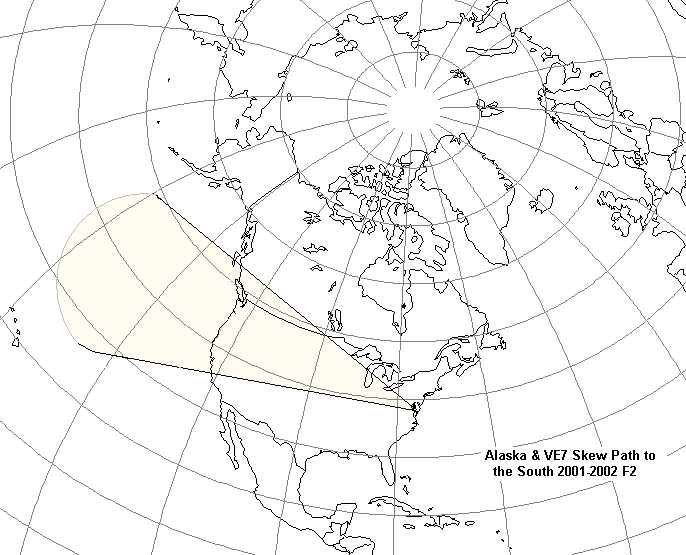Alaska Beaming Due North |
| Some interesting paths to Alaska were also worked during the 2001-2002 F2 season. Most of the time, propagation from the East Coast to Alaska seemed to favor stations farther north. F2 to the region generally began earlier and ended later at higher latitudes. On at least two separate days when conditions were particularly good at higher latitudes, it was possible to beam due north and work Alaskans via side scatter, or possibly some form of backscatter. On these occasions no direct path was available from here, though it was open direct to Alaska from W1 & VE1/9. Because of this, and the fact there was no noticeable auroral quality from the Alaskan's signals, the scatter zone was likely located well south of the Arctic circle, most probably somewhere within the path overlap between our respective beam headings. |

|
| It is true this path could have been pure backscatter, and indeed, some of the northern F2 was so strong during the 2001-2002 F2 season that on one occasion the VE8BY beacon was audible here only on backscatter beaming West. A slightly less skewed westerly path was also sometimes productive for working Alaskans and VE7s. Instead of the direct 320 degree path to KL7 and the 315 heading to the mid CO field region of VE7, Alaska was sometimes heard louder at 305 degrees, and VE7 at 295 degrees. In the case of VE7, once or twice propagation was only available with a beam heading slightly further south at around 280 degrees. Interestingly, the only path I had to WL7M (QRA BO49), who was worked October 26, 2001 and heard on two other occasions, was always somewhat south of true, while stations from far northern KL7 were virtually always direct. |

|
| Like the skewed European paths, the KL7 scatter path seems to be a function of highly ionized "hotspots" that allow for oblique beam headings. Interestingly, as time went on the paths would often change to direct, indicating that the skew path was often the first propagation route available. |
|
© David H. Craig 2002 |